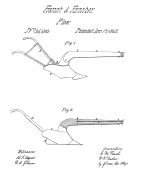
In the midst of the American Civil War, inventors W.H. Fancher and C.M. French of Waterloo, New York, receive a patent for the New and Improved Ordnance Plow, a horse-drawn plow outfitted with a firearm.

It was to be “used in border localities, subject to savage feuds and guerrilla warfare.” Many farmers living in Union border states endured Southern cavalry carrying out raids on their farmlands. The patent didn’t specify the caliber of gun the plow was to be outfitted with. It just described it as capable of firing “grapeshot or a piece of light ordnance… its capacity may vary from projectile of 1 to 3 pounds.” Civil War cannon typically fired balls weighing six to twelve pounds, so this is no mere rifle. More like an agricultural bazooka.
In the event of trouble, the farmer would theoretically unhitch his horses, thrust the iron plowshare into the soil (for stability against recoil), and fire at the marauders. The patent had several practical problems that prevented the machine from ever being built. One was visibility: raiders would eventually get wise to the ordnance plow and shoot the farmer-gunner before he could use it. And we’re also talking about a plow here, not a Ferrari. It’s cumbersome and not so easy to turn and plant. All an attacker had to do was flank his plow-packin’ target in order to knock him dead.
No, this wasn’t the first poorly devised combination in history, and it wouldn’t be the last. But it was surely one of the absolute worst.—DD